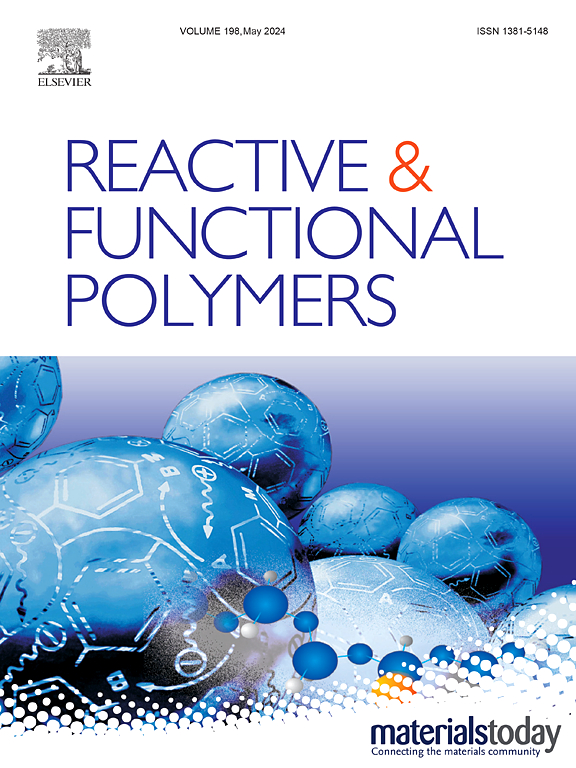3d打印基于聚丙烯酰胺/季壳聚糖的多功能水凝胶柔性传感器
IF 5.1
3区 工程技术
Q1 CHEMISTRY, APPLIED
引用次数: 0
摘要
基于水凝胶的可穿戴柔性压力传感器在人体健康和运动监测方面显示出巨大的应用潜力。然而,制造具有优异机械性能、灵敏度和稳定性的水凝胶传感器仍然具有挑战性。在这项研究中,我们开发了一种具有多功能功能的poloxomer -季铵盐化壳聚糖-聚丙烯酰胺(P407/QCS-PAAm)水凝胶。这些水凝胶具有高强度,耐冲击性,优异的导电性,亲水性和出色的抗菌性能。由于QCS提供的动态氢键作用,通过调节QCS的含量可以调节水凝胶的力学性能,拉伸强度为0.14 ~ 0.47 MPa,抗压强度为2.07 ~ 5.49 MPa。QCS携带的季铵基团增强了凝胶的电导率(0.29 S/m)和抑菌效果。此外,P407的掺入提高了水凝胶的亲水性。这些特性使凝胶成为可穿戴设备的优秀生物安全材料。值得注意的是,水凝胶前驱体表现出可调速率的溶胶-凝胶过渡特性,使3D打印成为可能。3d打印的P407/QCS-PAAm水凝胶传感器在宽应变范围(- 40 %至0 %应变)内具有高灵敏度(GF <; −0.5)。考虑到这些综合性能,凝胶在柔性可穿戴和3d打印电子设备中显示出巨大的潜力。本文章由计算机程序翻译,如有差异,请以英文原文为准。

3D-printable polyacrylamide/quaternary chitosan-based multifunctional hydrogel flexible sensors
Hydrogel-based wearable flexible pressure sensors show great potential for applications in human health and motion monitoring. However, fabricating hydrogel sensors with excellent mechanical properties, sensitivity, and stability remains challenging. In this study, we developed a poloxamer-quaternized chitosan-polyacrylamide (P407/QCS-PAAm) hydrogel with multifunctional capabilities. These hydrogels exhibit high strength, impact resistance, excellent electrical conductivity, hydrophilicity, and outstanding antimicrobial properties. Due to the dynamic hydrogen bonding provided by QCS, the mechanical properties of the hydrogel can be adjusted by regulating the QCS content, achieving tensile strengths ranging from 0.14 to 0.47 MPa and compressive strengths from 2.07 to 5.49 MPa. The quaternary ammonium groups carried by QCS enhance the gel's conductivity (0.29 S/m) and its bacteriostatic effects. Furthermore, the incorporation of P407 improves the hydrogel's hydrophilicity. These properties make the gel an excellent biosafety material for wearable devices. Notably, the hydrogel precursor exhibits rate-tunable sol-gel transition properties, enabling 3D printing. The 3D-printed P407/QCS-PAAm hydrogel sensors demonstrate high sensitivity (GF < −0.5) across a wide strain range (−40 % to 0 % strain). Considering these combined properties, the gel demonstrates significant potential for use in flexible wearable and 3D-printed electronic devices.
求助全文
通过发布文献求助,成功后即可免费获取论文全文。
去求助
来源期刊

Reactive & Functional Polymers
工程技术-高分子科学
CiteScore
8.90
自引率
5.90%
发文量
259
审稿时长
27 days
期刊介绍:
Reactive & Functional Polymers provides a forum to disseminate original ideas, concepts and developments in the science and technology of polymers with functional groups, which impart specific chemical reactivity or physical, chemical, structural, biological, and pharmacological functionality. The scope covers organic polymers, acting for instance as reagents, catalysts, templates, ion-exchangers, selective sorbents, chelating or antimicrobial agents, drug carriers, sensors, membranes, and hydrogels. This also includes reactive cross-linkable prepolymers and high-performance thermosetting polymers, natural or degradable polymers, conducting polymers, and porous polymers.
Original research articles must contain thorough molecular and material characterization data on synthesis of the above polymers in combination with their applications. Applications include but are not limited to catalysis, water or effluent treatment, separations and recovery, electronics and information storage, energy conversion, encapsulation, or adhesion.
 求助内容:
求助内容: 应助结果提醒方式:
应助结果提醒方式:


